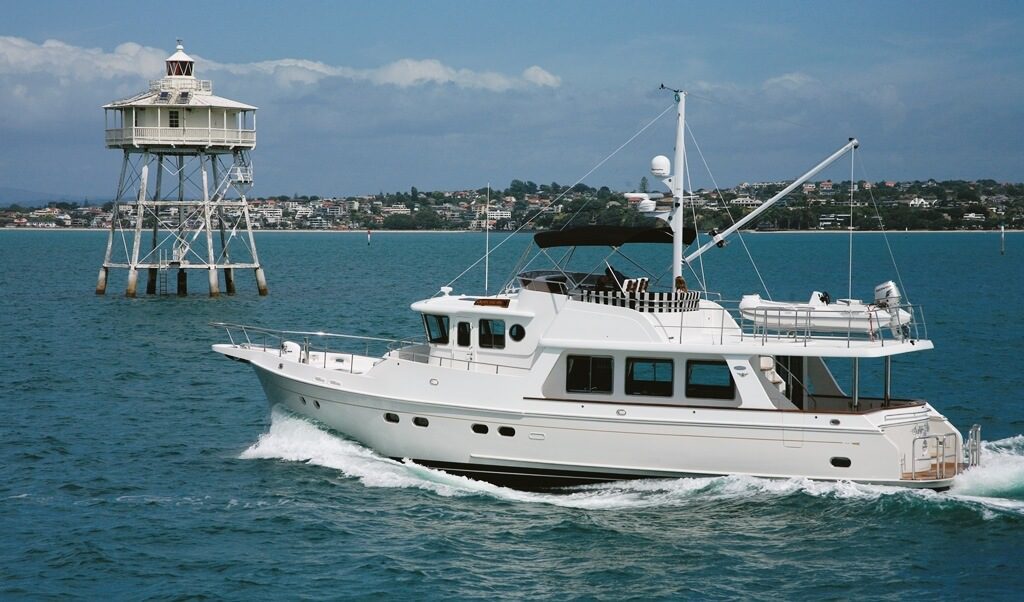Experience the sophistication of the past with the modern comforts of the future in Selene 55 Grape Escape is an outstanding example of just how far the Asian builders have come in terms of design and workmanship of trawlers and passagemakers.
The remarkable growth in interest of trawlers and passagemakers has been the result of an expanding range of vessels now available from Asia, none more so than from Mainland China and Taiwan. Jet Tern Marine, headed by the dynamic Howard Chen, is the builder of the Selene range of trawlers, which is unquestionably one of the marker leaders. From its factory on Dong Guan, Canton, it produces around thirty boats a year, from the compact Selene 36 through to the all-powerful Selene 75.
The name ‘Selene’ comes from the mythical Greek goddess of the moon. With that same spirit of excellence and beauty Selene ocean trawlers are emerging as a world leading brand in the luxury long range trawler market.
Grape Escape is something new for Jet Tern Marine, being the first Selene 55 formed by grafting on the euro stern of the Selene 59 to the Selene 53. The reason was the Kiwi owners preference was for the styling of the bigger boat and the layout and size of the smaller 53. The compromise was to bring both together, something that Jet Tern Marine was more than happy to do.
This also meant the construction of a whole new transom door to the lazarette area which now houses the washing machine, deep freeze and even a couple of bikes. Correspondingly, the cockpit roof has been extended also, so the entire cockpit area is under shelter.
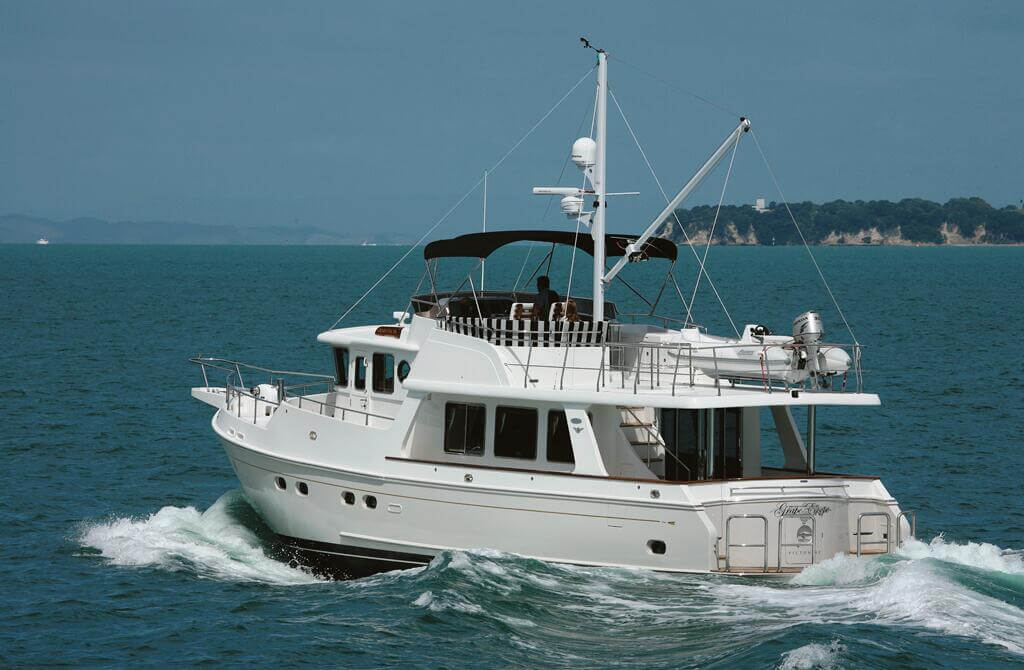
Grape Escape retains the popular curved staircase to the flybridge, but now has the added feature of a large rear cockpit alfresco dining area, plus double access to the boarding platform.
New Zealand Selene importer, Gary Erceg, said “Each Selene is a personal statement of its owner and we encourage our clients to work with the factory on all aspects of the layout so that the boat they get is exactly as they want it.”
Unlike many larger production yards, customisation is not an issue and so it is rare to see two similar sized Selenes exactly the same.
“Of the four “53s” in New Zealand all are quite different and that’s what makes them so special to their owners”, said Erceg.
Easy Viewing
Another first in Grape Escape is the double opening stainless steel sliding saloon doors, which accentuates the feeling of bringing the internal and external areas together. The standard design features a single opening Dutch door, with large rear port window.
Step inside the Selene 55 and you cannot help but be impressed with the high standard of finish. Chinese craftsmanship has come a long way since they first got into the leisure boat building market and the Selene 55 is an outstanding example of their skills.
Teak has been used throughout the boat, but you have the option of a huge variety of different timbers. A combination of high gloss and matt finish is a nice touch, with the black and gold fabrics and soft leathers finishing off the small ship appeal.
Being a semi custom vessel, the owners had a reasonably free reign when it came to layout. They stayed very much with the traditional package with an L-shaped settee and dining area to port, and to starboard a settee and forward galley. Both loungers can be extended to form generous double berths and the adjustable table can be extended with hidden leaves, when you have a full complement of dinner guests.
There are the usual built-in speakers throughout the boat for the entertainment system and a drop-down flat screen TV that hides away in the starboard vanity, which also houses a multi-temperature wine cooler. This is one area where the owners opted to be different and replaced the aft staircase to the owners’ stateroom and engine room with the vanity.
The galley is equipped with all the necessary appliances such as dishwasher, trash compactor, stove and microwave neatly hidden behind teak louvres. There is a full size fridge/freezer that comes with a built-in icemaker. Jet Tern Marine even includes a foldaway stainless splashguard for when using the stove. Grape Escape’s counter tops in the galley and ensuites are all granite, but you do have the choice of Corian or in fact just about whatever surface you want.
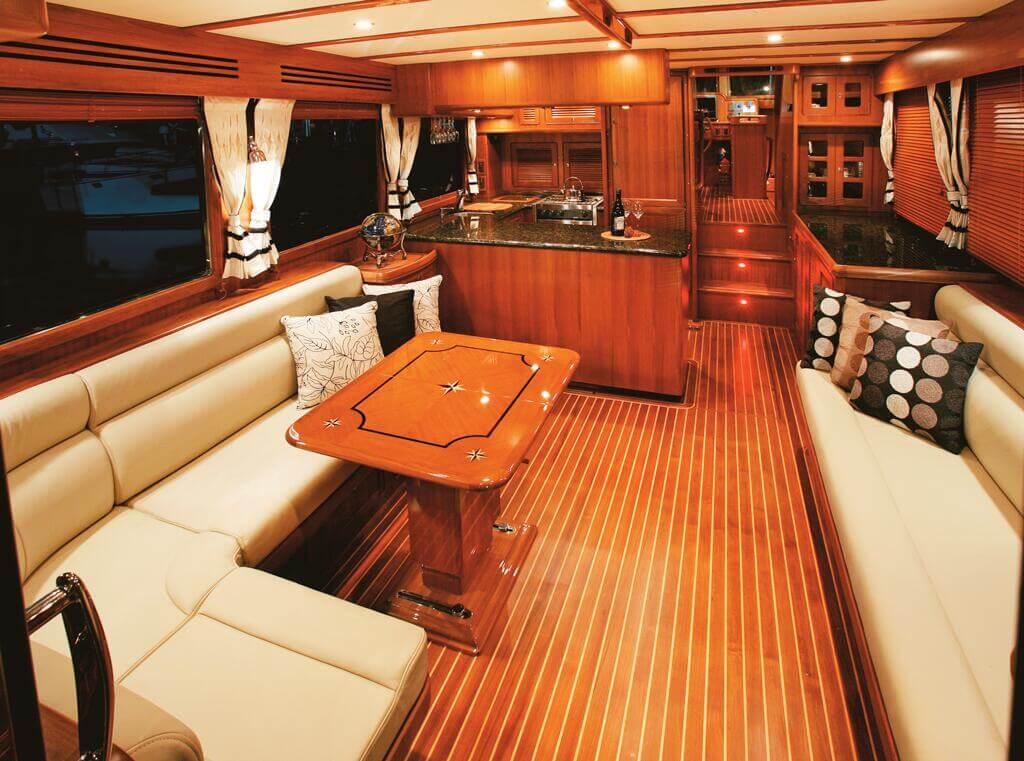
Real Wheelhouse
The wheelhouse is very much as you would expect in a trawler-style vessel with a central helm behind reverse sheer windows, twin Dutch doors for access to the side bulwarks, Portuguese bridge and a watch berth. Jet Tern Marine has made great use of the space, with areas such as the berth incorporating a pull-out extension to 2m, a full-size chart table and a dedicated chart drawer. The high seat sofa is a great place to sit when cruising and comes with a couple of handy drink holders built into the short teak arms.
While electronic navigation is the norm these days, paper charts are still a must have if you are serious about passage making, so Jet Tern Marine has made adequate provision for such a requirement.
An optional Stidd helm chair takes pride of place behind the ship’s wheel and an expansive teak veneer console and dash area. The latest Raymarine G Series is used with twin screens.
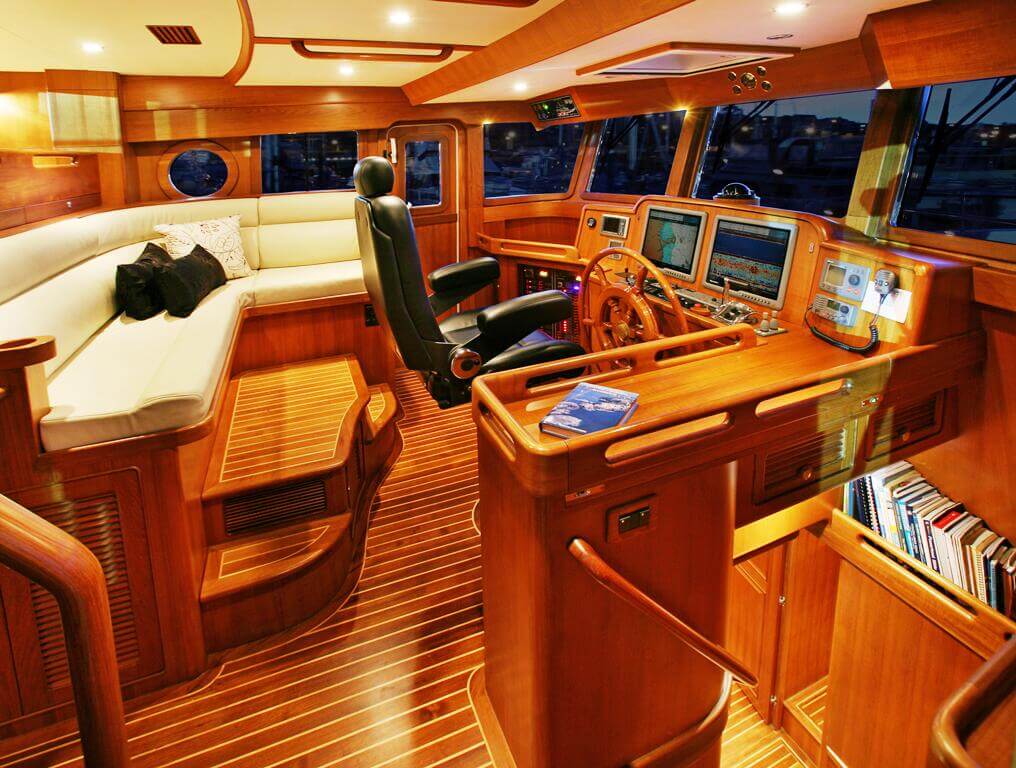
Three-Cabin Layout
From the wheelhouse, access is available down to the accommodation areas and also up to the flybridge. Grape Escape is a three-cabin, two-ensuite layout, but again, how you configure this area is your choice.
The master stateroom in Grape Escape has the large ensuite to starboard and the walkaround queen size berth running fore and aft to port. If you opt for the two cabins, the ensuite moves forward and the cabin opens out to the full beam. There is a preponderance again of teak everywhere, with plenty of lockers and storage areas to tuck all the gear away. If you don’t like the dark aspect of teak, Jet Tern Marine will fit the boat out in a lighter timber such as beech. Again, it is totally up to you.
The sole in the ensuite is a nice mix of black and white granite, with granite also used on the vanity counter. A large shower cubicle comes with a teak slatted seat as well as a teak grated floor panel. The mirrored ceiling really makes the ensuite look a lot larger than it is.
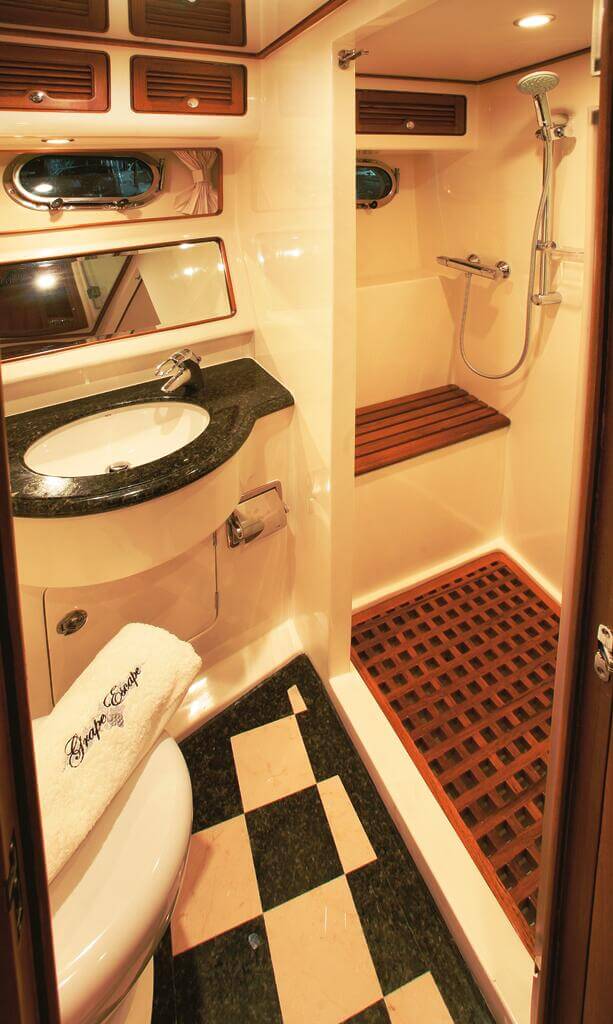
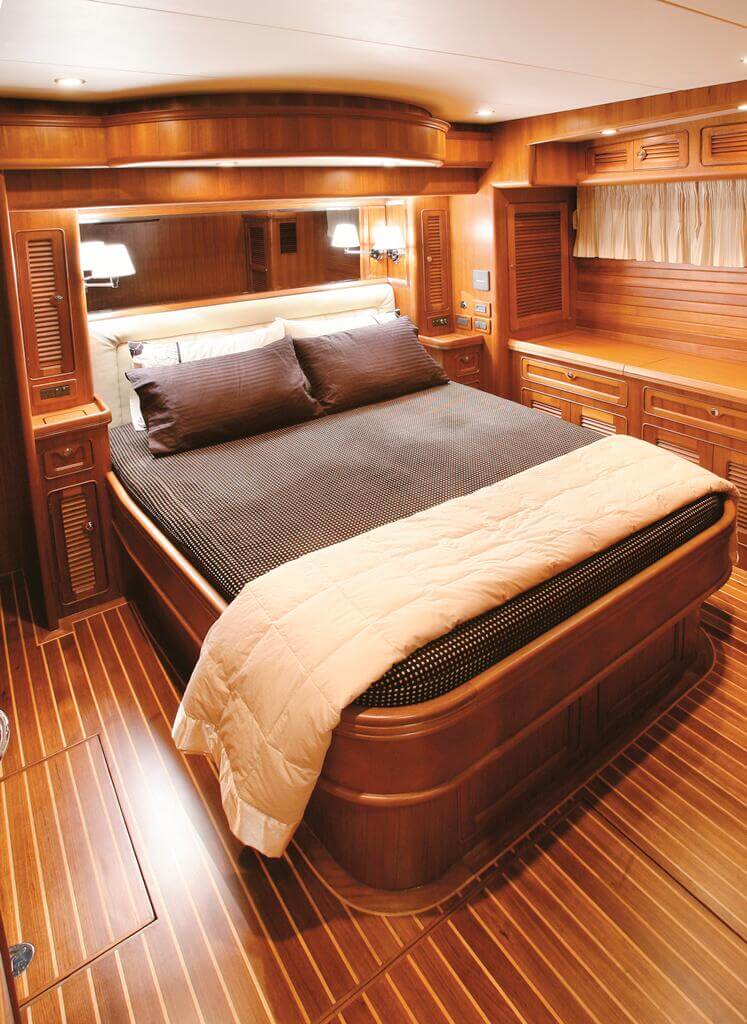
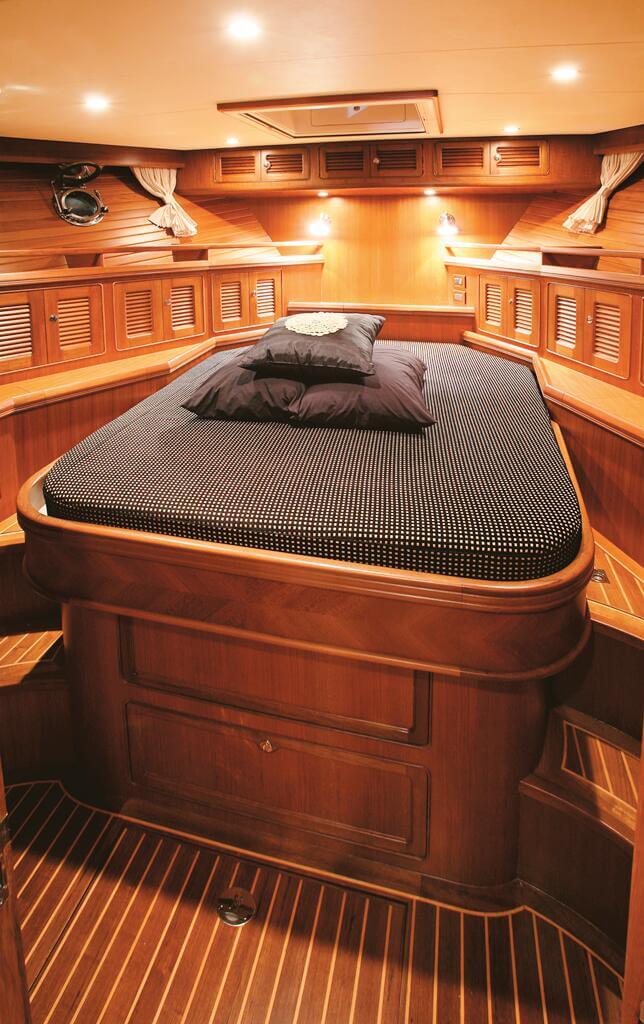
Open Cruising
Access to the flybridge is via the stairway from the pilothouse or from the cockpit. The Selene 55 comes standard with either an arch or a mast, with a soft bimini top and the option of a hardtop. Grape Escape has the soft bimini and mast, which also houses the radar dome and TV antenna, while doubling up as the davit crane for the tender.
Twin factory-made teak/GRP helm chairs are fitted and the grp fascia features a single Raymarine G Series screen. Visibility for the skipper is great and there is a relaxing lounger with clip-on cushions for the guests. With the dinghy away, the aft deck is all left for sunbathing.
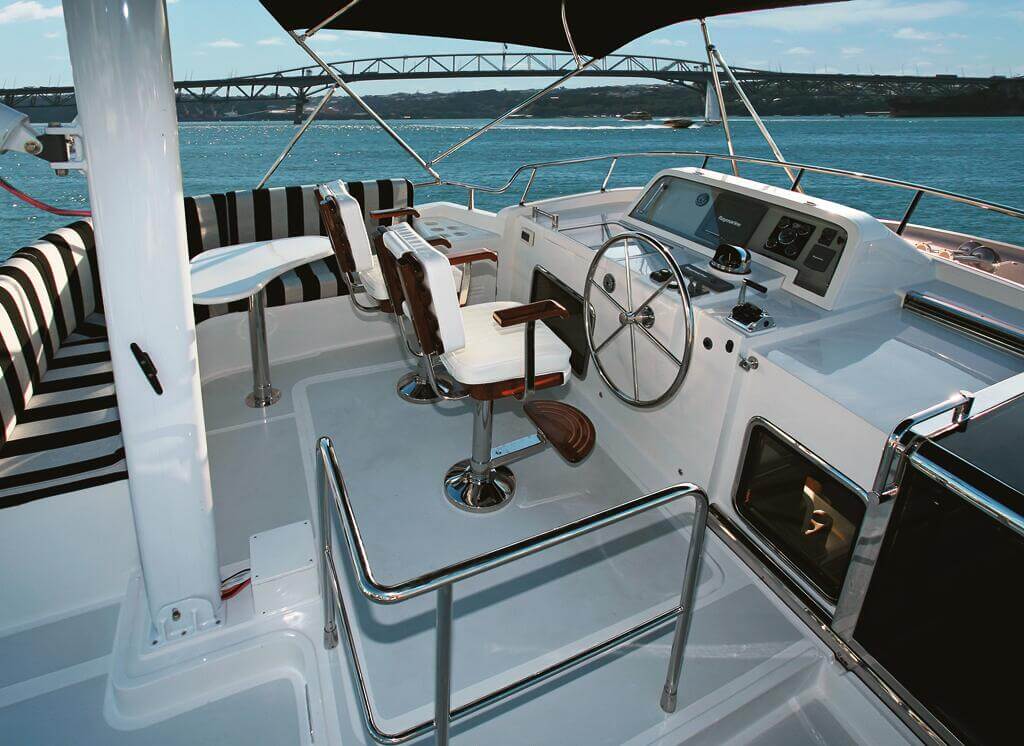
Slow & Economical
Grape Escape is powered by the standard propulsion package, a single Cummins QSL9 producing 405hp @ 2100rpm. While the brochure also offers the option of a single John Deere 6125AFM @ 341hp or twin Cummins QSBs @ 305hp, other engines such as Lugger and Yanmar are also available. A popular installation when choosing the single engine is for a wing engine, such as a 54hp Yanmar or an auxiliary propulsion system such as the Wesmar APU, which was fitted to Grape Escape (See side bar). Using the Northern Lights 20kW genset, the Selene 55 is good for 5.5 knots of very economical and quiet cruising when utilising the Wesmar APU.
The key to the long range of a passage-making trawler is operating at low speeds, well below the hull speed, where the engine can push the hull with maximum efficiency. For most trawlers, maximum range is achieved at S/L ratios (the ratio of speed in knots to the square root of the waterline length in feet) of under 1.0, i.e. at around 75% of ‘hull speed’.
However, many voyages don’t require the maximum range of the trawler. Careful hull design allows the vessel to operate at considerably higher S/L ratios – with a corresponding decrease in range, but a much higher speed for shorter voyages. The Selene 53’s S/L ratio of about 1.55 corresponds to a speed of about 10.8 knots.
The Selene 53 incorporates a “disappearing chine” concept designed to blend the favourable fuel economy and range of a full displacement hull with the higher speed capability of a semi-planing hull. The hull has very typical round bilges in the forward half of the hull, while the aft part of the hull shows more pronounced chines and a flatter section.
The design also incorporates a slightly concave or “hollow” area of the bottom near the stern. This hollow in the bottom tends to increase the water pressure under the hollow, which is precisely where the propeller is.
Pristine Engine Room
Jet Tern Marine doesn’t skimp or short change its clients when it comes to equipment and machinery. Attention to detail is paramount and everything is as good as it gets, well laid out and relatively easy to inspect or work on. Access to the engine room is provided from the owners’ stateroom or via the galley sole. Jet Tern Marine has even allowed for a total engine transplant, with the entire galley counter and part of the cabin roof being removable.
Anyone buying a trawler such as a Selene and seriously thinking about passage making knows the importance of clean fuel. Selene Trawlers now come equipped with the ESI Clean Fuel system as standard equipment. The ESI system not only cleans and decontaminates fuel, but provides a convenient way to transfer fuel between tanks. It is installed as a stand-alone system, directly connected to the fuel tanks, independent of the engine’s fuel supply system. Fuel is circulated using the system’s fuel transfer pump through the filter/water separator and the “De-Bug” fuel decontamination unit, and back into the tank. The system can even be set up to run automatically at pre-determined intervals, maintaining clean fuel even when the vessel sits idle for extended periods.
Liveaboard Cruising
The Selene 55 is a boat that provides plenty of liveaboard comfort. It’s a boat that lends itself to comfortable cruising around the coastal waters of New Zealand and Australia, but it also designed for serious passage making. It is also an extremely economical vessel to operate. According to figures provided by Jet Tern Marine, at around 7.8 knots, Grape Escape was using 31 litres per hour.
Since its introduction in 2002, the Selene 53 (and its variants such as the 55) has become one of the most popular models in the Selene range. It’s easy to see why.
Selene New Zealand has now sold eleven Selene’s into New Zealand over the past two years, ranging from the Selene 40 through to the Selene 57. If you want one, then be prepared to pay around $NZ1.8 million and take delivery in 10 months.
TECHNICAL SPECIFICATIONS
- Design Name: Selene 55
- Boat Name: Grape Escape
- Builder: Jet Tern Marine
Country of Origin China - Designer: Howard Chen
- Year Launched: 2009
- LOA: 18.85m
- LWL: 16.00m
- Beam: 5.08m
- Draft: 1.65m
- Displacement: 43,000kg
- Max Speed: 12 knots
- Cruise Speed: 9 knots
- Fuel Cap: 5300 litres
- Water Cap: 1500 litres
- Construction: GRP
- Engine : Cummins QSL9 @ 405hp

